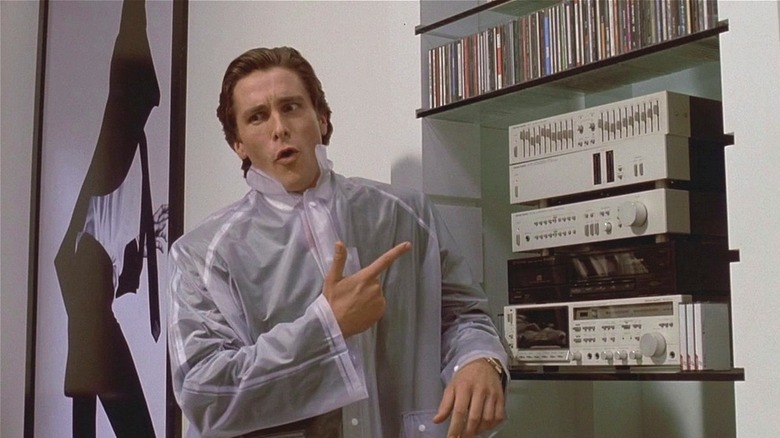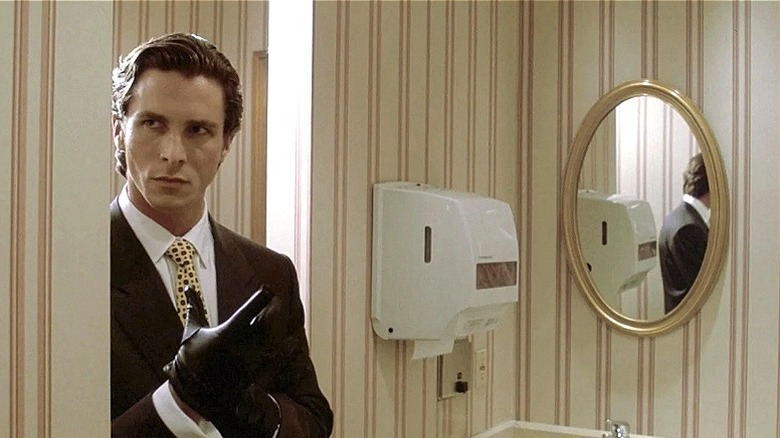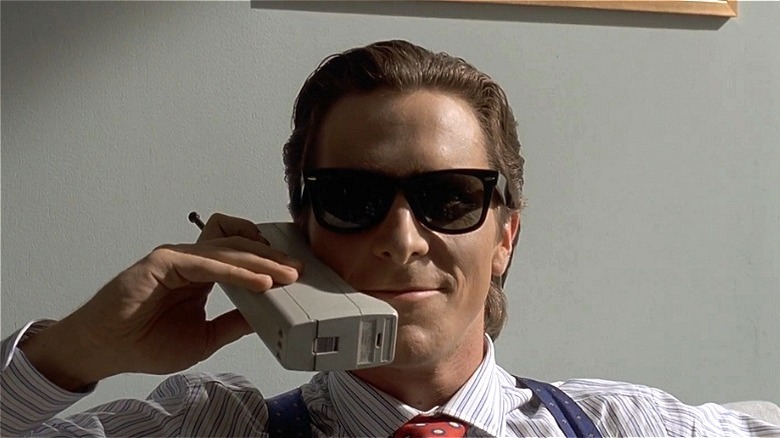Director Mary Harron Thinks She Knows Why Audiences Were Split On American Psycho
"There is an idea of a Patrick Bateman; some kind of abstraction. But there is no real me: only an entity, something illusory." NYC investment banker Patrick Bateman (Christian Bale) narrates these lines during his extensive luxury skincare routine in the opening minutes of Mary Harron's horror movie, "American Psycho." Based on Bret Easton Ellis' controversial novel of the same name, "American Psycho" presents Bateman as a caricature of a serial killer, mixing horror and humor to take a dig at the fragile, toxic masculinity that blooms in shallow, capitalist cultures. However, the film's intended tone has been heavily misinterpreted for a plethora of reasons, and the elusiveness of who Bateman is and what he is supposed to stand for still haunts contemporary discourse surrounding the film.
Published in 1991, Ellis' novel caused considerable upheaval at the time due to its graphically violent content and transgressive subject matter. Interestingly, Ellis' approach to his own work is intensely double-edged: although he offers a deliberate indictment of consumerist/yuppie culture through Bateman's character, there are traces of self-identification/insertion at the same time. For Ellis, "American Psycho" was an outlet to deal with his own "isolation and alienation" while "slipping into a consumerist kind of void that was supposed to give [him] confidence and make [him] feel good," yet ultimately failed (via The Oregonian). If we are to consider authorial intent for a second, Ellis shares a split relationship with his fictional monster, who seems both cool and abhorrent to him at the same time.
However, Harron and Bale never tried to make the character cool. "The one thing you couldn't do was think Bateman was in any way cool," she clarified to Little White Lies (LWL) during a discussion about the seminal film. In the same interview, Harron explained why audiences had mixed reactions to "American Psycho," a film that still evokes divided opinions.
'People didn't know how to take it'
In the LWL interview, Mary Harron said she gravitated towards adapting Bret Easton Ellis' novel because it was "so strong and controversial," to the point of being a career risk. Although Harron knew that parts of the novel were incredibly violent, she was unaware of the tongue-in-cheek, satirical parts that were overlooked when the book hit stores. Although she didn't know if it would work when she started writing, Harron went on to balance violence and satire in her adaptation, but test audiences had mixed feelings:
"People didn't know how to take it. We did test screenings and it split people down the middle; it inspired very strong reactions...everyone was so outraged. People didn't know when it was supposed to be funny, when it was okay to laugh. They thought it was just a violent slasher."
Harron attributes this kind of split reaction to Bateman being a "very slippery, complicated and interesting" character, which links back to Ellis' fragmented relationship with Bateman — something that unconsciously creates a schism within the book's storyline itself. The test audience's reactions to "American Psycho" seem reactionary at best, with the violence overshadowing Harron's efforts to weave a sharp-witted, satirical tale about a narcissistic, homicidal Wall Street dude. Over time, the film garnered a cult following and a reappraisal in terms of its themes, which remain relevant to this day.
The film is currently a source of endless memes, revolving around scenes like the business card sequence, and Patrick's unhinged rant before he axes Paul Allen in a fit of rage. Although most folks treat these memes the way they are meant to be — tongue-in-cheek visual reactions that underline the film's satire — many approach Bateman as an aspirational yardstick for a certain kind of toxic masculinity.
Bateman is (unfortunately) the face of the sigma male grindset
The fundamental misunderstanding of Patrick Bateman, and by extension, the intention behind "American Psycho," pushes way beyond a misreading of the film's text and subtext. Instead of viewing Bateman as a vessel of toxic, vapid hypermasculinity who revels in '80s excess and consumerism, folks who identify as "sigma male" have appointed Bateman as the poster child of a rebellious, "lone-wolf" brand of masculinity (read: toxic). The same memes that are meant to be enjoyed ironically are now being rebranded as serious, inspirational content. Bateman's "You can always be thinner, look better" is now being unironically used in Tiktok edits that glamourize the character's everyday habits, including his obsession with hegemonic masculinity and erratic emotional outbursts.
Needless to say, the issue with treating Bateman as a cool-as-hell, aspirational standard of masculine brilliance is more deep-rooted than a few thousand misguided memes about "American Psycho." Bateman earned himself a fanbase of real-life, Wall Street traders. Bateman is obsessed with superficiality and ends up treating himself and everyone around him like commodities, needing to adhere to his standard of perfection. As a result, he objectifies women and brutalizes them on several occasions with ease, and butchers men who threaten his position as the ultimate masculine upholder of consumerist success. Whether these instances of abuse are real or imagined is a separate conversation altogether (we'll let you interpret the ending). What matters is that they're real for Bateman, who power walks through life with the entitlement of a mediocre white man.
Anyhoo, this is your sign to revisit Mary Harron's film, which deserves to be appreciated for its dark comedic humor, nuanced tonal shifts, and a fun, appropriately unhinged performance by Christian Bale. I could go on, but I have to return some videotapes.


